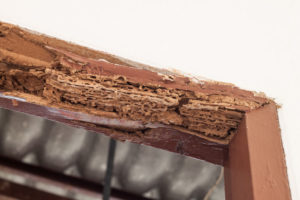The manner in which a house is constructed can influence its susceptibility to termite infestations. Certain home construction materials and architectural styles can make termite infestations relatively difficult to detect in completed homes. Certain types of construction can also provide numerous access points for termites in finished homes. Although termites infest a home’s timber components in order to consume the nourishing cellulose contained within, houses and buildings made of brick, concrete and other cellulose-free materials are not immune to termite infestations and termite-induced damages.
In many parts of the world, most notably Europe, apartments are constructed from brick masonry. These structures are referred to as “attached brick terraces,” and they are similar to the townhouses that are common in North America. Unfortunately, the exposed brick exterior of attached terrace structures is relatively vulnerable to rainwater. This is because barriers made from damp-proof materials are usually not installed beneath the exterior brick surfaces of these structures. As a consequence of this particular design flaw, rainwater absorbs into the masonry, causing moisture levels to progressively rise over a period of time. Termites find the high-moisture environment within these buildings to be an ideal habitat. Invading subterranean termites tunnel through moist brick masonry in order to access internal wood sources, such as a terrace’s timber frame, hardwood floors, stairway timbers, door jambs and roof timbers.
The construction of brick veneer over a concrete slab is the type of construction that tends to conceal termite infestations more effectively than any other construction type. Termites can easily access the timber frame located beneath the veneer by entering through the edges of the underlying slab, which is concealed by paving, garden beds or other obstructions. However, termite inspectors are not able to access the timber frame within these homes due to the slab acting as a barrier. This allows termites to continuously damage the concealed timber frame without pest control intervention. The timber frame in these homes is also made from Oregon or radiata pine in most cases. This type of timber is highly desired by termites, but the maple and cedar joinery timbers that are accessible within brick veneer homes are not sought after by termites. In other words, termite-infested timber within brick veneer homes is concealed from inspectors. It has also been noted that brick veneer homes are often built over termite-rich areas of land, which significantly contributes to the high rate of irreparable termite damages documented as occurring within these homes.
Are you curious as to how your home’s construction materials and architectural style influences the likelihood of developing a termite infestation?
Tags: Termite Control




